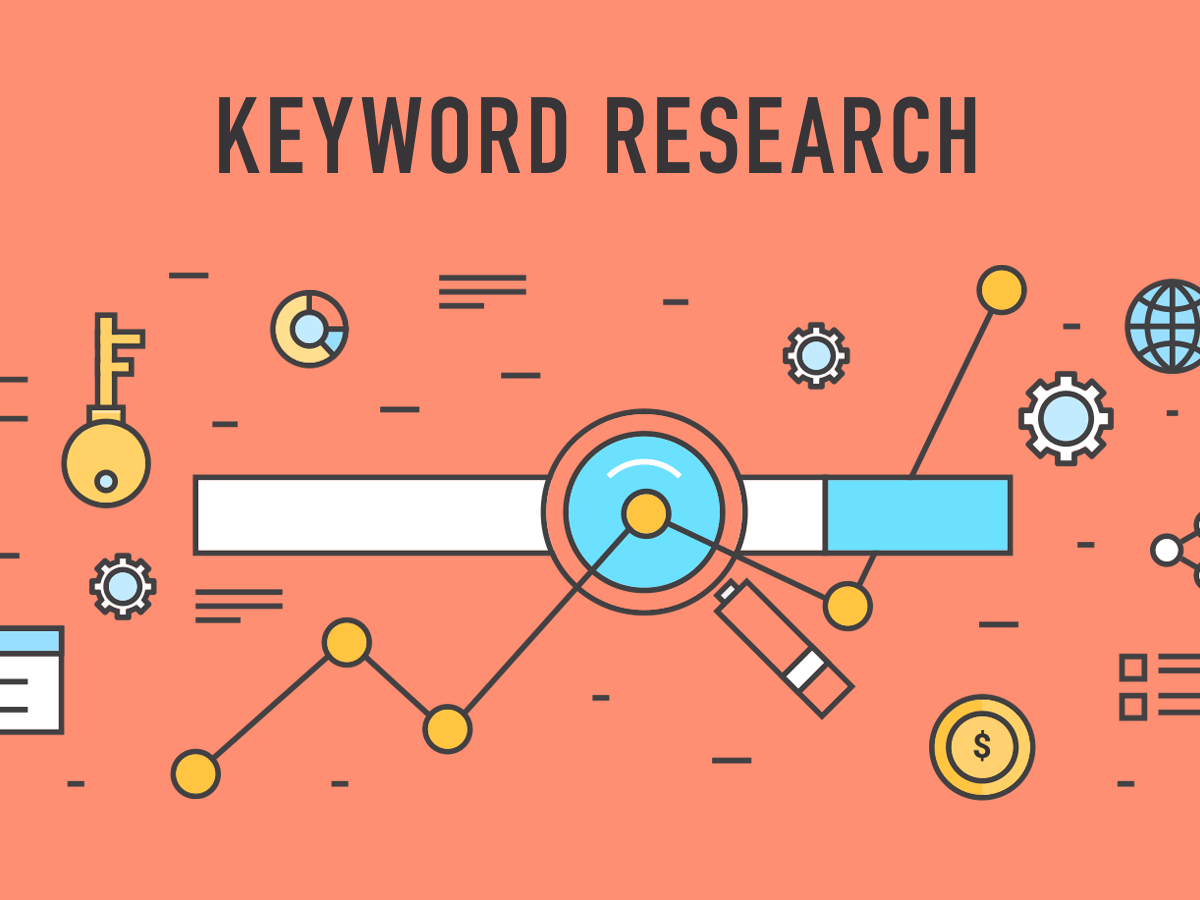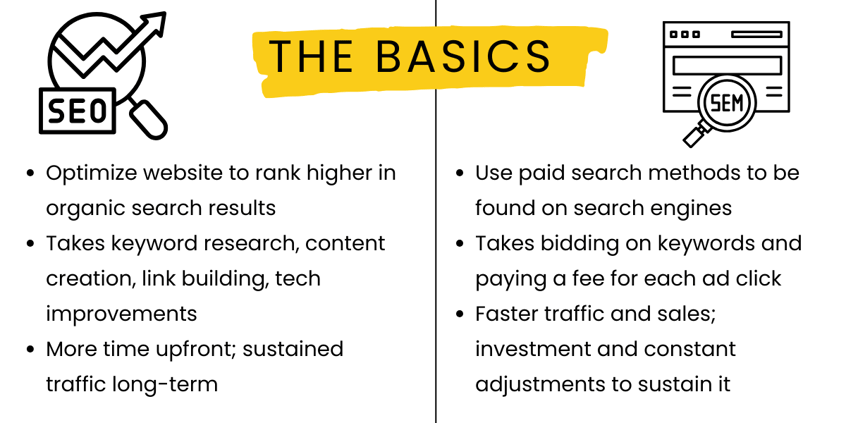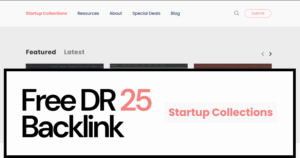Search Engine Optimization (SEO) and Search Engine Marketing (SEM) are key strategies for boosting visibility on search engines. SEO focuses on improving organic search results through webpage optimization and creating quality content, while SEM uses paid ads to drive traffic quickly. The main differences between the two are the type of search results they target, the time to see results, and the costs involved. SEO targets organic results and takes months or years to show return, but can lead to free traffic in the long run. On the other hand, SEM offers immediate traffic through paid ads but at an ongoing cost. Both require keyword research and optimization. When deciding between SEO and SEM, consider your budget, ROI goals, timing, and target keywords. For best results, combining both strategies can offer a mix of fast growth and sustainable long-term success.
Understanding SEO and SEM
SEO, or search engine optimization, is the practice of improving the content and structure of a website to increase its visibility in organic search engine results. This involves strategies like keyword research, on-page SEO, and building backlinks. SEO is a long-term strategy that focuses on improving a website’s presence and authority within search engines like Google. The goal is to attract more organic traffic over time through high rankings on relevant search queries.
SEM, or search engine marketing, includes SEO but also involves paid strategies to increase visibility in search engine results. This typically means using pay-per-click (PPC) advertising to place ads in front of potential customers. The main advantage of SEM is that it can deliver immediate results by putting a website at the top of the search engine results page. However, this requires an ongoing investment in ad spend.
The key difference between SEO and SEM lies in how traffic is generated. SEO focuses on organic, unpaid methods to improve rankings, while SEM includes both organic efforts and paid advertising to achieve visibility. SEO tends to be more time-consuming but cost-effective in the long run, whereas SEM provides quicker results at a higher immediate cost. For optimal results, businesses often use a combination of both methods. By understanding and effectively leveraging the strengths of each, one can create a comprehensive strategy for online visibility.
SEO: Pros and Cons
One of the main advantages of SEO is its cost-effectiveness. Organic traffic generated through SEO doesn’t incur a direct cost for each click, unlike paid advertising. This makes it an attractive option for long-term strategies focused on building a strong online presence. Additionally, SEO builds credibility and trust among users as top-ranking pages are often considered more reliable and authoritative.
However, SEO comes with its own set of challenges. It requires a significant amount of time and effort to achieve and maintain high rankings in search engine results. The algorithms used by search engines are constantly evolving, necessitating continuous updates and adjustments to SEO strategies. Competition can also be intense, making it hard for new or smaller websites to rank well.
Prioritizing SEO makes the most sense when you’re aiming for long-term growth and have the resources to dedicate to ongoing optimization efforts. If building brand credibility and trust within your industry is crucial, or if you want to capitalize on organic traffic without a recurring cost, SEO is the way to go. It’s particularly beneficial for established businesses looking to maintain their online presence and attract a steady flow of organic traffic.
SEM: Pros and Cons
One of the main advantages of SEM is its ability to provide immediate visibility and results. Unlike SEO, which can take months to build organic traffic, SEM allows businesses to place their ads in front of potential customers almost instantly through paid efforts. Additionally, SEM offers precise targeting options, enabling marketers to reach specific demographics, locations, and user behaviors. This translates to higher chances of conversions and a better return on investment, especially for competitive industries.
However, SEM is not without its challenges. The costs associated with SEM can be high, especially for competitive keywords. Marketers must continually manage and optimize campaigns to ensure they are cost-effective, which can be time-consuming. Ad fatigue is another issue; users might become less responsive to ads over time, necessitating constant updates and creativity in campaigns. Also, reliance on a single platform (like Google Ads) can be risky if there are policy changes or shifts in platform popularity.
Prioritizing SEM is particularly beneficial for short-term campaigns or when a business needs to generate quick traffic and leads. New businesses or those launching products can leverage SEM to quickly gain market visibility. It is also suitable for promotions, sales events, or any scenario where immediate results are critical. However, combining SEM with an ongoing SEO strategy can produce the best long-term outcomes by balancing immediate visibility with sustainable organic growth.
Keyword Research for SEO and SEM

Credits: searchengineland.com
Keyword research tools can significantly enhance both SEO and SEM strategies. Tools like Google Keyword Planner, SEMrush, Ahrefs, and Moz are highly effective. These tools help identify the search volume, competition, and relevance for particular terms. Using accurate data, you can pinpoint keywords that align with your goals and audience trends.
Selecting the right keywords involves understanding your target audience and their search behavior. First, compile a list of broad terms related to your industry. Then, narrow it down to specific, long-tail keywords that are more likely to convert. It’s crucial to balance between high search volume keywords and low competition keywords for optimal results.
Optimizing keywords in SEO involves incorporating them naturally within your website content, meta descriptions, headers, and alt tags. For SEM, keywords are crucial for ad targeting and bidding strategies. Ensure that ads and landing pages align with the selected keywords to enhance relevance and quality score, thus improving your ad performance and reducing costs.
Combining SEO and SEM Strategies
Credits: linkedin.com
Integrating SEO and SEM can yield significant benefits for your digital marketing efforts. SEO focuses on optimizing your website to boost organic search rankings, while SEM leverages paid search advertising to enhance visibility. By combining both, you can capture both targeted organic traffic and paid traffic, maximizing your reach. This dual strategy also helps in refining your keyword strategy. Data from SEM campaigns can provide insights into high-performing keywords that you can then incorporate into your SEO efforts for even better results.
To successfully combine SEO and SEM, start by conducting thorough keyword research. Identify keywords that perform well in paid campaigns and optimize your website content around these terms. Next, ensure your landing pages are optimized for both SEO and user experience to improve quality scores and organic rankings. Additionally, coordinate your content marketing and link-building efforts to support both strategies. Regularly review analytics to monitor the performance of integrated campaigns, adjusting tactics as needed based on data-driven insights.
Measuring the impact of combined SEO and SEM strategies involves tracking several key metrics. Monitor organic traffic, paid traffic, and overall conversion rates to gauge effectiveness. Use tools like Google Analytics to evaluate the performance of specific keywords and assess which terms drive the most valuable traffic. Additionally, track metrics such as bounce rate, average session duration, and click-through rate to understand user engagement. This holistic approach to measurement allows you to optimize both strategies continuously, ensuring you achieve the best possible results.
- Comprehensive understanding of audience targeting
- Clear keyword strategy development
- Increased brand awareness through organic and paid channels
- Enhanced website traffic and engagement metrics
- Better resource allocation and budget management
- Improved return on investment (ROI)
- Streamlined marketing efforts for consistency
Choosing the Right Strategy

Credits: thezoeteam.com
When deciding between SEO and SEM, budget plays a crucial role. SEO typically requires an initial time investment to optimize content for search engines and may involve hiring experts. Its ongoing costs are relatively lower. SEM, on the other hand, requires continuous funding for paid advertisements, making it ideal for businesses with a flexible budget looking for rapid results.
Return on investment (ROI) varies between SEO and SEM. SEO generally yields a higher long-term ROI as organic search results can continue to drive traffic without recurring costs. SEM provides immediate visibility and can generate quick leads or sales, but once the ad campaigns stop, so does the traffic. Thus, SEM is suitable for short-term campaigns aimed at instant gains.
Aligning strategies with your goals is essential. If you aim for immediate visibility and swift traffic, SEM is likely the better choice. This is particularly useful for promotions and time-sensitive offers. However, for sustainable growth and long-lasting presence, investing in SEO is more beneficial. SEO gradually builds authority and ranking, making it ideal for long-term objectives.
Frequently Asked Questions
1. What is the main difference between SEO and SEM?
SEO, or Search Engine Optimization, helps your website get organic traffic through search engines like Google, by improving your content and structure. SEM, or Search Engine Marketing, involves paid tactics like Google Ads to get traffic to your site.
2. Can I use both SEO and SEM together?
Yes, you can use both SEO and SEM together. Using both can help you get immediate traffic from SEM while you build up your organic traffic through SEO over time.
3. Which one is faster to see results: SEO or SEM?
SEM is faster because you pay for ads and get immediate traffic once your campaign is live. SEO takes longer because you need to improve your site and build up authority, which can take months.
4. Is SEO or SEM better for long-term growth?
SEO is better for long-term growth because it helps you build a sustainable source of organic traffic. Once you rank well in search engines, you can get continuous traffic without ongoing costs.
5. What kind of businesses should use SEO vs. SEM?
Businesses with a longer timeline and smaller budgets might prefer SEO because it’s cost-effective over time. Companies looking for immediate results or those in competitive markets might use SEM to quickly boost their visibility.
TL;DR SEO (Search Engine Optimization) focuses on organic search strategies to increase website traffic through content and technical improvements. SEM (Search Engine Marketing) involves paid advertising efforts like PPC (Pay-Per-Click) to boost visibility. SEO has long-term benefits but takes time; SEM offers immediate results but at a cost. Effective keyword research, leveraging tools, and combining both strategies can maximize impact. Choose the approach based on budget, goals, and timeframe for ROI.





